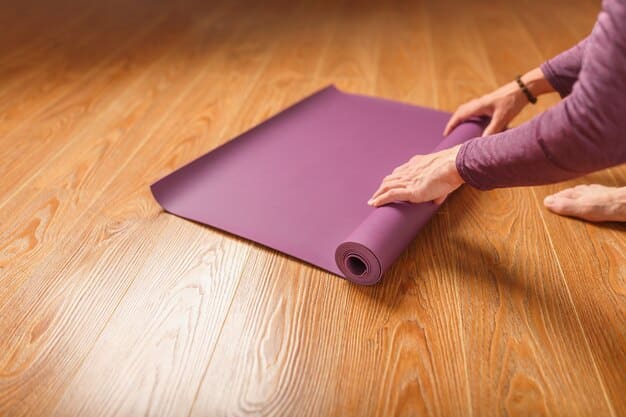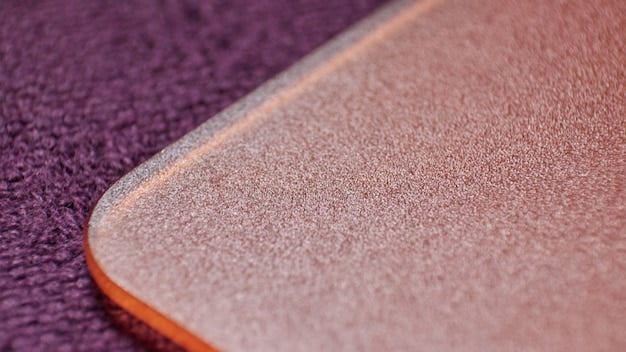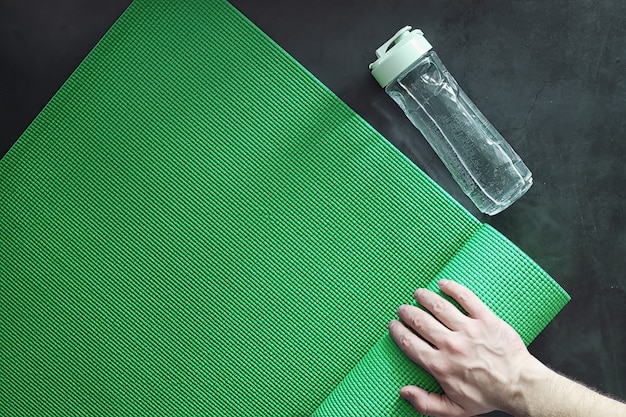Is Your Yoga Mat Toxic? Eco-Friendly Options for 2025

As we move into 2025, the question of “Is Your Yoga Mat Toxic?” becomes increasingly relevant, urging a comparison of eco-friendly options and understanding their impact on health and the environment.
Are you unrolling hidden dangers along with your yoga mat? The question, Is Your Yoga Mat Toxic? A Comparison of Eco-Friendly Options and Their Impact on Your Health in 2025, deserves serious consideration as we become more aware of the materials we use every day.
Understanding the Potential Toxicity of Yoga Mats
Many traditional yoga mats are made from materials that can leach harmful chemicals. Let’s dive into what makes some mats toxic and what to look out for.
Common Toxic Materials in Yoga Mats
Traditional yoga mats often contain PVC, phthalates, and heavy metals, which can pose health risks. Understanding these materials is the first step in making an informed choice.
PVC, or polyvinyl chloride, is a common plastic used in many yoga mats due to its durability and affordability. However, PVC can release volatile organic compounds (VOCs) into the air, contributing to indoor air pollution. Phthalates, added to make PVC more flexible, have been linked to hormonal disruption and other health issues. Heavy metals, sometimes used as stabilizers or pigments, can also be harmful if ingested or absorbed through the skin.
Health Risks Associated with Toxic Mats
Exposure to these chemicals can lead to various health problems, from skin irritation to more serious long-term effects. It’s crucial to recognize these risks.
The health risks associated with toxic yoga mats range from mild skin irritation to more severe long-term effects. VOCs released by PVC can cause headaches, dizziness, and respiratory irritation. Phthalates have been linked to endocrine disruption, potentially affecting reproductive health. Prolonged exposure to heavy metals can damage the nervous system and other organs. Choosing a non-toxic mat minimizes these health hazards.
- PVC concerns: Potential release of VOCs, impacting air quality.
- Phthalate dangers: Possible hormonal disruption, affecting reproductive health.
- Heavy metal risks: Nervous system and organ damage from prolonged exposure.
Therefore, being informed about the composition of your yoga mat is paramount. Opting for mats made from safer, natural materials can significantly reduce your risk of exposure to these harmful substances and protect your health.
Exploring Eco-Friendly Yoga Mat Materials
Fortunately, the market offers a variety of eco-friendly alternatives that are both safe for you and kinder to the planet. Let’s explore some of the best options.

Natural Rubber
Natural rubber is a sustainable material that provides excellent grip and cushioning. It’s a popular choice for eco-conscious yogis.
Natural rubber is harvested from rubber trees and processed into yoga mats. These mats offer superior grip, preventing slips during poses, and provide comfortable cushioning for joints. Natural rubber is biodegradable, making it an environmentally friendly choice compared to synthetic materials. However, some individuals may be allergic to latex, so it’s essential to check the material composition if you have a latex allergy.
Cork
Cork is another fantastic option, offering natural antimicrobial properties and a unique texture. It’s also sustainably harvested.
Cork yoga mats are made from the bark of cork oak trees, which regenerates after harvesting, making it a sustainable material. Cork is naturally antimicrobial, resisting bacteria and mold growth, making it ideal for hot yoga or sweaty practices. Cork mats also provide excellent grip, especially when slightly damp, and offer a firm, supportive surface. They are biodegradable and recyclable, further reducing their environmental impact.
Jute
Jute is a natural fiber that’s durable and biodegradable. It adds a unique texture to yoga mats and is often combined with other materials.
Jute yoga mats are made from the fibers of the jute plant, a sustainable and renewable resource. Jute is known for its strength and durability, making it a long-lasting option. Jute mats provide a textured surface that enhances grip and prevents slipping. They are also biodegradable and compostable, minimizing their environmental footprint. Jute is often combined with natural rubber or other materials to improve cushioning and comfort.
- Rubber Benefits: Excellent grip and cushioning, biodegradable.
- Cork Advantages: Antimicrobial, sustainable, and provides good grip.
- Jute Properties: Durable, biodegradable, and textured for better grip.
In summary, opting for yoga mats made from natural rubber, cork, or jute presents a healthier, more sustainable alternative to traditional PVC mats, aligning your yoga practice with your environmental values.
Assessing the Environmental Impact of Your Yoga Mat Choice
Choosing an eco-friendly mat isn’t just about your health; it’s also about the planet’s well-being. Let’s consider the environmental impact of different materials.
Lifecycle Assessment of Yoga Mats
Consider the entire lifecycle of your yoga mat, from production to disposal, to understand its full environmental impact.
A lifecycle assessment of yoga mats involves evaluating the environmental impact at each stage of the mat’s life. This includes the extraction of raw materials, manufacturing processes, transportation, use, and end-of-life disposal. PVC mats, for example, require energy-intensive production processes and release harmful pollutants. Eco-friendly mats, such as those made from natural rubber or cork, have a lower environmental impact due to sustainable harvesting and biodegradable properties.
Biodegradability and Compostability
Opt for mats that are biodegradable or compostable to minimize waste and reduce your environmental footprint.
Biodegradability and compostability are essential factors to consider when choosing a yoga mat. Biodegradable mats break down naturally over time, reducing landfill waste. Compostable mats can be added to compost piles, further minimizing their environmental impact. Natural rubber and jute mats are inherently biodegradable, while cork mats are compostable. Selecting mats with these properties ensures that your yoga practice aligns with sustainable waste management practices.
Ethical Considerations
Support brands that prioritize ethical sourcing and manufacturing practices to ensure fair labor and environmental protection.
- Evaluate the lifecycle: Understand the complete environmental impact.
- Choose biodegradable options: Reduce landfill waste with natural materials.
- Support ethical brands: Promote fair labor and environmental standards.
Ultimately, selecting a yoga mat with minimal environmental impact requires careful consideration of its entire lifecycle, from sourcing to disposal, supporting ethical brands, and choosing biodegradable or compostable materials to reduce waste.
Navigating Certifications and Labels
With so many options available, it can be challenging to determine which mats are truly eco-friendly. Certifications and labels can help you make an informed decision. Let’s explore some key certifications to look for.

Oeko-Tex Certification
Oeko-Tex certification ensures that the mat has been tested for harmful substances and is safe for human health.
Oeko-Tex certification is a widely recognized standard that ensures textiles and yoga mats have been tested for harmful substances and pose no risk to human health. This certification verifies that the mat meets strict criteria for over 100 different chemicals and substances, providing assurance that it is free from toxins and safe for use. Look for the Oeko-Tex Standard 100 label when choosing your yoga mat.
Global Organic Latex Standard (GOLS)
GOLS certification guarantees that the natural rubber in the mat is sourced from organic farms and processed according to strict environmental and social standards.
The Global Organic Latex Standard (GOLS) certification ensures that the natural rubber used in yoga mats comes from certified organic farms and is processed according to stringent environmental and social criteria. This certification guarantees that the rubber production is sustainable, ethical, and free from harmful chemicals. GOLS-certified mats provide assurance that the rubber meets high standards for both environmental protection and fair labor practices.
Other Relevant Labels
Look for other labels such as Fair Rubber, which ensures fair labor practices, and certifications for sustainable forestry, which indicate responsible sourcing of wood-based materials like cork.
In addition to Oeko-Tex and GOLS, other labels can help you evaluate the sustainability of your yoga mat. Fair Rubber certification ensures that rubber farmers and workers receive fair wages and safe working conditions. Certifications for sustainable forestry, such as the Forest Stewardship Council (FSC), indicate that wood-based materials like cork are sourced from responsibly managed forests. Looking for these labels provides additional assurance of ethical and environmental responsibility.
- Oeko-Tex: Tested for harmful substances and safe for health.
- GOLS: Organic rubber sourced sustainably and ethically.
- Fair Rubber: Ensures fair labor practices.
By understanding and seeking out these certifications and labels, you can confidently choose a yoga mat that aligns with your health and environmental values, ensuring a safe and sustainable practice.
Maintenance and Care for Longevity
Proper care can extend the life of your eco-friendly yoga mat and keep it hygienic. Let’s discuss some essential maintenance tips.
Cleaning Your Mat
Regular cleaning is essential to remove sweat, dirt, and bacteria. Use a gentle, natural cleaner and avoid harsh chemicals.
Regular cleaning is crucial for maintaining the hygiene and longevity of your yoga mat. Use a gentle, natural cleaner made from ingredients like vinegar, tea tree oil, or mild soap. Avoid harsh chemicals, which can damage the mat and release harmful substances. Wipe the mat down after each use and allow it to air dry completely before rolling it up. Deep clean your mat periodically to remove accumulated dirt and bacteria.
Storage Tips
Store your mat in a cool, dry place away from direct sunlight to prevent damage and degradation.
Proper storage is essential for preventing damage and degradation of your yoga mat. Store your mat in a cool, dry place away from direct sunlight and extreme temperatures. Avoid storing the mat in humid environments, which can promote mold and bacteria growth. Roll the mat loosely to prevent creases and cracks. Using a yoga mat bag can protect it from dust and damage during storage and transportation.
Extending Mat Lifespan
Rotate your mat regularly to distribute wear and tear evenly. Also, consider using a yoga towel for added protection during sweaty practices.
To extend the lifespan of your yoga mat, rotate it regularly to distribute wear and tear evenly. Consider using a yoga towel during sweaty practices to absorb moisture and protect the mat from excessive wear. Avoid using abrasive cleaners or scrub brushes, which can damage the surface. With proper care and maintenance, your eco-friendly yoga mat can provide years of comfortable and sustainable practice.
- Clean Regularly: Use gentle, natural cleaners to remove sweat and dirt.
- Store Properly: Keep the mat in a cool, dry place away from sunlight.
- Extend Lifespan: Rotate the mat and use a yoga towel for protection.
In summary, proper maintenance, including regular cleaning and mindful storage, is key to preserving the quality and extending the life of your eco-friendly yoga mat, ensuring a hygienic and sustainable practice for years to come.
Future Trends in Eco-Friendly Yoga Mats (2025)
Looking ahead to 2025, anticipate even more innovative and sustainable options in the yoga mat market. Let’s explore some emerging trends.
Innovative Materials
Researchers are constantly exploring new materials, such as algae-based foams and mycelium-based composites, which could revolutionize the yoga mat industry.
In the coming years, expect to see even more innovative materials being used in yoga mats. Algae-based foams, derived from sustainable algae cultivation, offer a biodegradable and renewable alternative to synthetic materials. Mycelium-based composites, made from the root structure of mushrooms, provide a lightweight, strong, and compostable option. These materials hold the potential to revolutionize the yoga mat industry, further reducing its environmental impact.
Closed-Loop Systems
More companies are adopting closed-loop systems, where old yoga mats are recycled into new products, minimizing waste and promoting circularity.
Closed-loop systems are gaining traction in the yoga mat industry, with more companies adopting practices to recycle old mats into new products. This approach minimizes waste and promotes circularity by keeping materials in use for as long as possible. Companies may offer take-back programs where customers can return their old mats for recycling. The recycled materials are then used to create new yoga mats or other products, reducing the demand for virgin resources.
Customization and Personalization
Expect to see more customized and personalized yoga mats, tailored to individual needs and preferences, further enhancing the yoga experience.
- Innovative Materials: Algae-based foams and mycelium-based composites are emerging.
- Closed-Loop Systems: Recycling old mats into new products to minimize waste.
- Customization: Personalized mats tailored to individual needs.
To conclude, the future of eco-friendly yoga mats promises even more sustainable and innovative options, with the potential for algae-based foams, closed-loop recycling systems, and personalized designs set to shape the market in 2025, fostering environmental responsibility and enhancing the yoga experience.
| Key Point | Brief Description |
|---|---|
| 🌱 Eco-Friendly Materials | Natural rubber, cork, and jute are sustainable options. |
| 🧪 Toxicity Risks | PVC mats can contain harmful chemicals like phthalates. |
| ✅ Certifications | Look for Oeko-Tex and GOLS for safe and sustainable mats. |
| 🔄 Future Trends | Algae-based foams and closed-loop recycling systems are emerging. |
FAQ
▼
Yoga mats are often considered toxic when they contain materials like PVC, phthalates, and heavy metals. These substances can release harmful chemicals, potentially leading to skin irritation, respiratory issues, or even hormonal disruption with prolonged exposure.
▼
Look for mats made from natural rubber, cork, or jute. Certifications like Oeko-Tex and GOLS can indicate that the mat has been tested for harmful substances and is produced sustainably, ensuring it’s a safer and more environmentally friendly option.
▼
Cork yoga mats are naturally antimicrobial, durable, and provide excellent grip, especially when slightly damp. Cork is also a sustainable material, harvested from the bark of cork oak trees, which regenerates after harvesting, making it an eco-conscious choice.
▼
Clean your mat with a gentle, natural cleaner made from ingredients like vinegar or mild soap. Avoid harsh chemicals, which can damage the mat and release harmful substances. Wipe the mat down after each use and allow it to air dry completely before rolling it up.
▼
By 2025, expect to see more innovative materials like algae-based foams and mycelium-based composites. Additionally, closed-loop systems where old yoga mats are recycled into new products, as well as increased customization options, will likely become more common.
Conclusion
As we become more conscious of the materials we use, choosing an eco-friendly yoga mat is a step towards protecting both our health and the environment. By understanding the risks associated with toxic materials and exploring sustainable alternatives, you can ensure your yoga practice aligns with your values.





